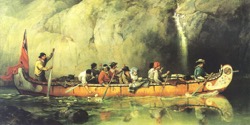Difference between revisions of "Canoe"
(Created page with "File:lighterstill.jpgright|frame ==Origin== from Spanish ''canoa'', from Arawak, from Carib ''canaoua'' . The word canoe comes from the...") |
m (Text replacement - "http://" to "https://") |
||
| Line 2: | Line 2: | ||
==Origin== | ==Origin== | ||
| − | from Spanish ''canoa'', from Arawak, from Carib ''canaoua'' . The [[word]] canoe comes from the [ | + | from Spanish ''canoa'', from Arawak, from Carib ''canaoua'' . The [[word]] canoe comes from the [https://en.wikipedia.org/wiki/Island_Carib_language Carib] ''kenu'' (dugout), via the Spanish ''canoa''. |
| − | *[ | + | *[https://en.wikipedia.org/wiki/16th_century 1555] |
==Definition== | ==Definition== | ||
*1:a narrow, keelless boat with pointed ends, [[propelled]] by a paddle or paddles. | *1:a narrow, keelless boat with pointed ends, [[propelled]] by a paddle or paddles. | ||
==Description== | ==Description== | ||
| − | A '''canoe''' is a lightweight narrow boat, typically pointed at both ends and open on top, propelled by one or more seated or kneeling paddlers facing the direction of travel using a single-bladed [ | + | A '''canoe''' is a lightweight narrow boat, typically pointed at both ends and open on top, propelled by one or more seated or kneeling paddlers facing the direction of travel using a single-bladed [https://en.wikipedia.org/wiki/Paddle paddle]. In the UK, however, the term ''canoe is'' also commonly used for [https://en.wikipedia.org/wiki/Kayak kayaks] despite being "technically incorrect". |
| − | Canoes are used for racing, [ | + | Canoes are used for racing, [https://en.wikipedia.org/wiki/Whitewater_canoeing whitewater canoeing], touring and camping, freestyle, and general [[recreation]]. The intended use of the canoe dictates its hull shape and construction material. |
| − | Historically, canoes were [ | + | Historically, canoes were [https://en.wikipedia.org/wiki/Dugout_(boat) dugouts] or made of bark on a wood frame, but construction materials evolved to canvas on a wood frame, then to [https://en.wikipedia.org/wiki/Aluminum aluminum]. Most modern canoes are made of molded plastic or composites such as [https://en.wikipedia.org/wiki/Fiberglass fiberglass]. Until the mid-1800s the canoe was an important means of [[transport]] for [[exploration]] and trade, but then [[transitioned]] to [[recreational]] or sporting use. Canoeing has been part of the [https://en.wikipedia.org/wiki/Canoeing_and_kayaking_at_the_Summer_Olympics Olympics] since 1936. In places where the canoe played a key role in history, such as the northern United States, Canada, and New Zealand, the canoe remains an important theme in popular culture. |
| − | Canoes can be [[adapted]] to many [[purposes]], for example with the addition of sails, outboard motors, and [ | + | Canoes can be [[adapted]] to many [[purposes]], for example with the addition of sails, outboard motors, and [https://en.wikipedia.org/wiki/Outriggers outriggers].[https://en.wikipedia.org/wiki/Canoe] |
[[Category: General Reference]] | [[Category: General Reference]] | ||
Latest revision as of 23:42, 12 December 2020
Origin
from Spanish canoa, from Arawak, from Carib canaoua . The word canoe comes from the Carib kenu (dugout), via the Spanish canoa.
Definition
- 1:a narrow, keelless boat with pointed ends, propelled by a paddle or paddles.
Description
A canoe is a lightweight narrow boat, typically pointed at both ends and open on top, propelled by one or more seated or kneeling paddlers facing the direction of travel using a single-bladed paddle. In the UK, however, the term canoe is also commonly used for kayaks despite being "technically incorrect".
Canoes are used for racing, whitewater canoeing, touring and camping, freestyle, and general recreation. The intended use of the canoe dictates its hull shape and construction material.
Historically, canoes were dugouts or made of bark on a wood frame, but construction materials evolved to canvas on a wood frame, then to aluminum. Most modern canoes are made of molded plastic or composites such as fiberglass. Until the mid-1800s the canoe was an important means of transport for exploration and trade, but then transitioned to recreational or sporting use. Canoeing has been part of the Olympics since 1936. In places where the canoe played a key role in history, such as the northern United States, Canada, and New Zealand, the canoe remains an important theme in popular culture.
Canoes can be adapted to many purposes, for example with the addition of sails, outboard motors, and outriggers.[1]
